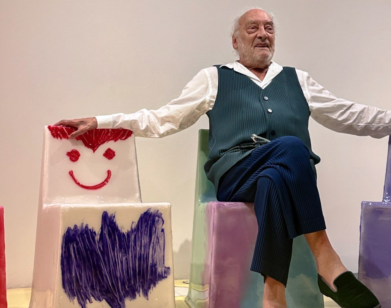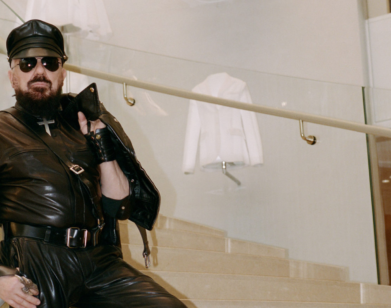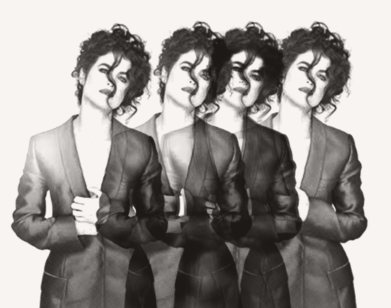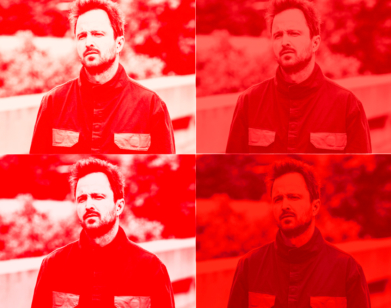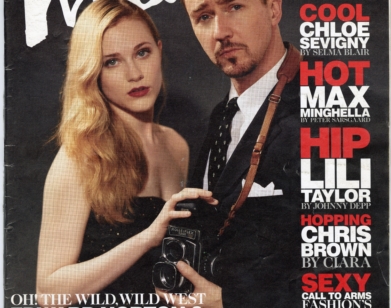Es Devlin and Bjarke Ingels on the books that inspire their futuristic vision

Bjarke Ingels doesn’t just plan buildings, he builds cities. At this moment the Danish architect is working on more than five expansive New York-based projects, the most anticipated and subversive of which is The Eleventh (The XI), two spiraling intertwined buildings on one square block between Hudson River and The High Line. As part of the planning process, Ingels has teamed up with filmmaker and visual artist, Es Devlin, to create a multi-sensory immersive experience at the site of the future building, called The XI Gallery. The installation includes a 3D map of New York City, including the future sites of many of Ingels’ upcoming projects, a 360-degree film haiku that examines the thought process behind the materials Ingels uses, and finally, “Dance,” a piece inspired by the relationship between both parts of The Eleventh.
But those who think Devlin and Ingels might be an odd pairing have missed the point of both artists. Sitting down with the duo, it’s clear many of the same thoughts and practices inspire their creations, namely the ways in which we can survive them. Both Devlin and Ingels produce work not for the present, but for the future, as evidenced alone by The Eleventh and XI Gallery. And both believe they’ve found the secret to lasting work: collaboration—oh, and a few philosophy books.
ES DEVLIN: We should do a reading list. Who would be on yours?
BJARKE INGELS: I’m currently reading [Douglas Hofstadter’s 1979 book] Gödel, Escher, Bach, because I met with Jonah Nolan and Lisa Joy, the creators of Westworld. I think what fascinates me so much about Westworld, and about Jonah in general is—did you know he co-authored all of the scripts that Chris Nolan has ever done? Memento was based on a short story that Jonah had written and together they adapted it into the film. So, he’s incredibly good at this self-referential thing, which is almost its own work of art. To make a work of art, you need to make sure the work is fed from its surroundings. But what makes it a life—or a great work—on its own, is that it can live without them. I think about that a lot in terms of my projects. If it’s justification is only how it fits in, if what it fits into stops being for whatever reason, then the thing falls apart. But if it’s fed by its surroundings and creates a world of its own, then it becomes what Hofstadter refers to as a “strange loop.” You have created more than art—you have created a life.
DEVLIN: Right.
INGELS: But what I also really loved about watching Westworld was that the science and the philosophy around artificial intelligence is so sophisticated, but it never feels like it’s been dumbed down for the audience. They’re never estimating the attention and intelligence of its viewers.
DEVLIN: That’s a species I’m quite familiar with: the audience. I think they’re never to be underestimated. They’re ridiculously sophisticated, and we’ve touched on this already—the expanding and contracting timespans of our various practices — but the concentration of the interaction between an audience and a very condensed three hour world that they experience in a theater, or any place of congregation, is such that you very immediately feel every beat of what an audience is receiving and intuiting, you know? But because I want to make this conversation an essential reading list, my next book would be The Order of Time by Carlo Rovelli. His area of expertise is loop quantum theory. Effectively, the nature of understanding of time is more an implication of the shape of our brains than any extent of physics. That idea is very compelling to me—that time as we understand it is emotional, and always related to one’s own position in it. So, I see you a Carlo Rovelli for your Gödel, Escher, Bach. What are you going to raise me?
INGELS: I have this friend Andri Snær Magnason, an Icelandic writer, and his most recent book is called The Casket of Time. In it, there’s this new product called the Timebox where you can plug yourself into it, and because it’s so fine-grained time can’t pass through it. So, it’s almost like tupperware for human beings. But you follow this story of a family living in Iceland during the financial crisis, and everybody is talking about how things are getting worse and worse. So, everybody gets this idea that they can use the Timebox and just wait it out. But of course, that means that eventually everything just falls asleep. So, I think it’s strangely relevant in a lot of ways. But overall, he’s become increasingly fascinated by time and has a theory that I completely subscribe to: that the way you perceive time is a function of how long you’ve already lived. So, that’s why when you’re two or three, the first of December to Christmas Eve is like ‘AHHHHHH’ —because it’s like 3 percent of your entire life thus far. Whereas for me, 3 percent of my entire life would be two or three years. So, of course, the older you get, a set amount of time is a smaller quantum of what you’ve already lived. It makes perfect sense. I buy that 100 percent.
DEVLIN: Right, me too.

INGELS: Earlier we were talking about how I’m so, so insanely jealous of Es’ instant response she gets when she makes a set or something, like how you instantly see how people are responding to it because you can hear them clapping or whatever. In architecture it’s a really, really slow and long process. So, you’re talking about two completely different time scales. Like right now, we’re working on the Dry Line, which is this park around Manhattan that’s going to keep it dry the next time something like Sandy comes. We’ve already been working on it for five years, and we’re just getting ready to break ground. It’ll be another decade or so before it’s done. So, when you talk about things like climate change, it feels abstract and that it belongs to future generations. But if I were to ask you, “When do you think there will be no one left alive on earth that you have loved directly at some point?” Let’s say you’ll live another 70 years. So, when you’re about to die, you will have a grandchild or great-grandchild that’s your favorite little gem. He or she is going to live at least another 100. So 170 years in this case, but it could be more, that is directly relevant to someone that you have loved. That’s not some kind of future, far off generation. It should be a kind of awakening to make you feel entirely responsible to make the future we want to live in. I know it does for me, and my work—even if it’s going to take a while.
WEISS: It seems that both of you are reading a lot—and thinking a lot—about the intersection of time and technology, and how it relates to humanity. Are those ideas also present in your work?
DEVLIN: The thing is, Bjarke’s building cities. I can’t think of anybody else who is doing that much. I mean, on the interactive map, there’s what? Five of your buildings?
INGELS: Yeah, I think we have a few happening on the West Side—there’s the Spiral, The Via, The War Pyramid, all the way down to the World Trade Center.
DEVLIN: But the books that we’re reading are useless to anyone as long as they’re just books. They’re only of any use if they go through the mind of a man like Bjarke then come out through his hands and into the building and into the choices that he makes. So, I think the people that these buildings will speak to, that this room will speak to, are the people whose minds these books need to reach.
INGELS: But also, to bring it home here, I want to mention the book Sapiens. Sapiens has this idea of fiction as an element that enables collaboration among many more than what you can navigate just through personal relationships. So, certain fictions, like the idea of a company, the idea of a country, the idea of a religion, the idea of money create exchanges of value, power and effort, and how that allows for collaboration between the many. So, when you look at the list of contributors to The Eleventh and this space, it’s quite a long list of disciplines, and when you go to another construction site a couple blocks north, there are 150 more people walking around in orange vests. When you are doing something in a city like New York, at the scale of something like The Eleventh, it’s important to the experience that it’s almost like a miniature community, and that there is actually room and requirement for many different statements, or many different expressions, within something that is of course, a coherent whole, but also has surprises and appearances from many differences of abilities to make it feel urban, and alive.
DEVLIN: That makes me think of this Yuval Noah Harari book, Homo Deus. Have you read it? I just got to the last chapter, and it’s quite interesting. His final idea is, it turns out, all this time we think we’ve been evolving as a species, it’s actually been the information that’s been evolving, and we’ve just stayed the same.
INGELS: No, but do you know Douglas Coupland? He has this book, I think it’s called JPod, and he talks about this moment where we’ll pass the limit where there will be more information stored outside the human brain than the total storage capacity of all human brains combined. That means, after that point, we can’t access all information and devour it because we’re too small as individuals. We have to collaborate. I guess that’s the secret of life.
DEVLIN: Right, like we’re the husks. We’re just the skin outside the real thing.


